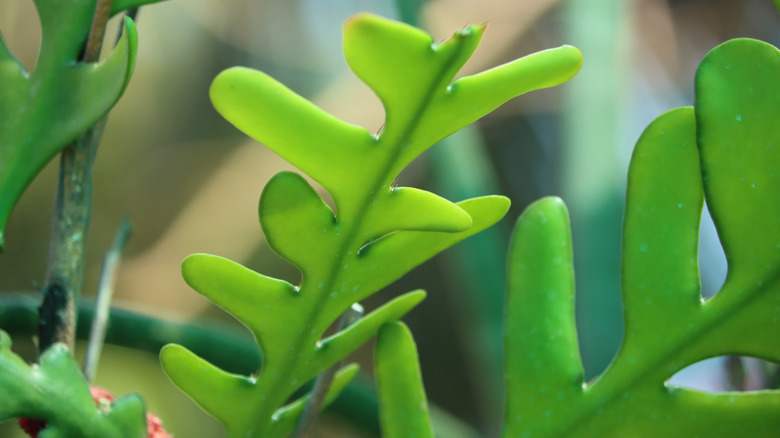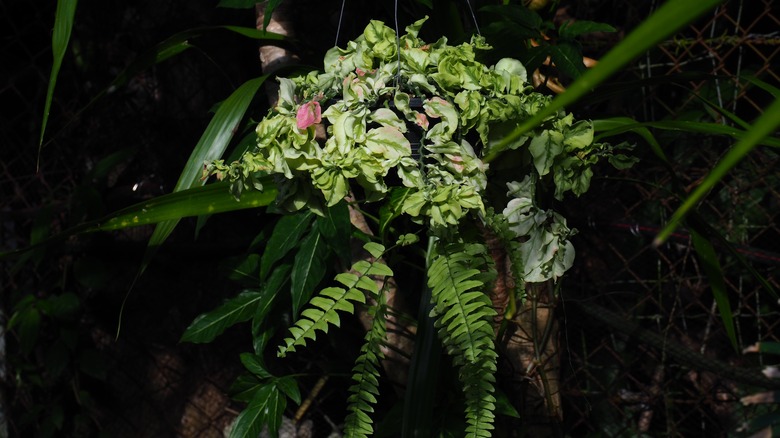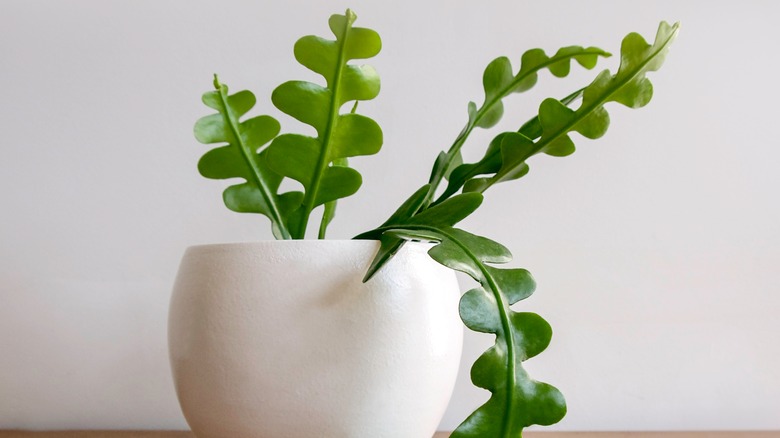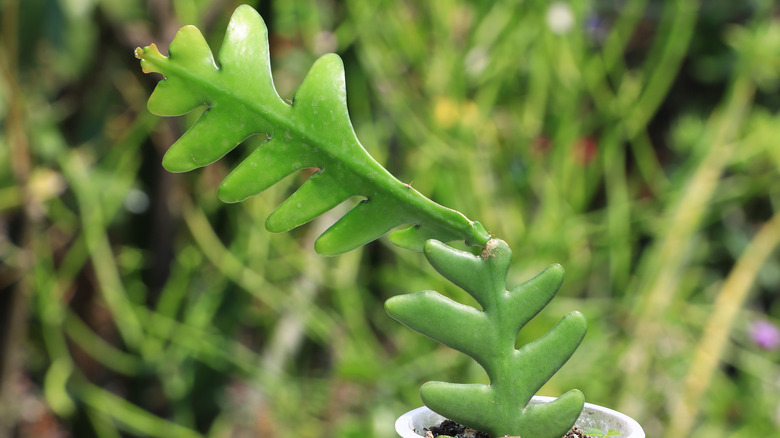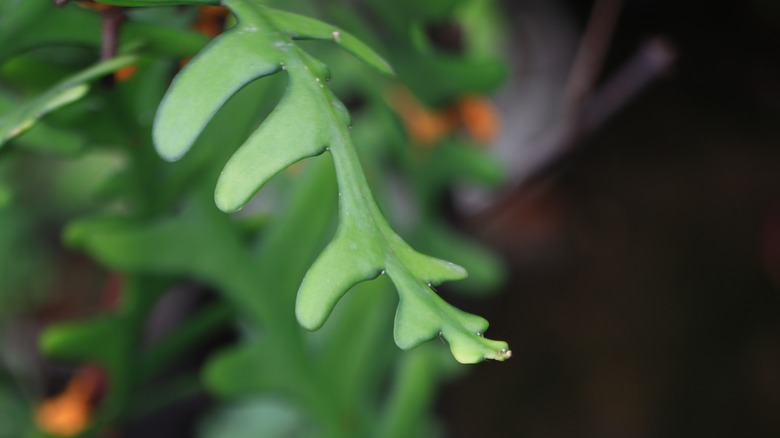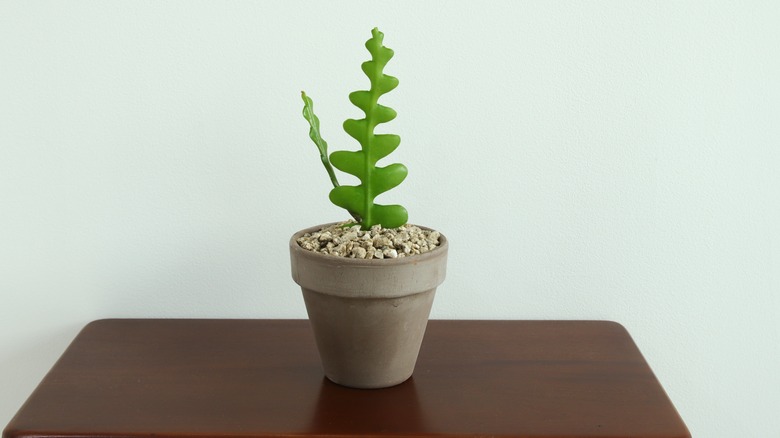How To Care For A Fishbone Cactus
Native to Mexico, the fishbone cactus (Disocactus anguliger) is an epiphytic cactus with a preference for humid, tropical environments over the arid conditions typical to cacti (per The Spruce). The plant is also known as the zig zag, ric rac, and orchid cactus due to its unique shape; its stems have a teeth-like form, almost as if cut with pinking shears.
Another unique aspect of the zig zag cactus is that it trails down, making it an ideal hanging plant, which is uncommon for most cacti. They also have the potential to bloom, sporting white, yellow, and even pink flowers. That is a sporadic occurrence for indoor fishbone cacti, though, most commonly happening when grown outdoors in humid and hot climates. Not only is the fishbone cactus visually stunning, unique, and easy to care for, but it is also completely non-toxic to humans, cats, and dogs, according to The Guardian. This plant also doesn't have the dangerous spikes typical to cacti, which can get frustratingly stuck in pets', children's, and adults' fur or skin. Keep reading to learn how to care for this unique tropical cactus.
How to use fishbone cactus in garden
Fishbone cacti are most commonly grown indoors due to the specific conditions they require year-round. Since they are found in tropical areas of Mexico, they need lots of heat and humidity consistently. Balcony Garden Web says the plant grows as perennial outdoors in USDA hardiness zones 10 through 12. However, if you aren't in those regions, you can bring your fishbone cactus outdoors during the summer, as long as the humidity stays around 60%, as per The Spruce. In this instance, fishbone cacti will look gorgeous growing out of a hanging basket on your front porch or back patio.
For those who can grow the plant year-round, you can put it in a basket. Other plants that grow well and look beautiful with fishbone cacti include snake plants, Mandevilla vines, and jade plants, Succulents HQ notes. Finally, the cactus prefers dappled shade when planted outdoors, so consider growing it under a tree or other large frond plants.
How to grow fishbone cactus
Fishbone cacti are generally easy to find at plant nurseries and garden centers, so picking one up to add to your houseplant collection shouldn't be difficult. According to Sprouts & Stems, if you want more of the plant or have a friend willing to give you a cutting, the zig zag cactus is quite easy to propagate in water or soil. To obtain a cutting, remove a healthy and strong stem as close as possible to the base with clean and sharp scissors or shears — the sharper the shears, the better the plant will heal from the cut. Then, let the plant dry out for a few days and callus over, which will prevent root rot from releasing water.
To propagate in water, fill a jar with room temperature water and add the cutting to the jar. Wait until the roots have developed and grown at least 3 inches, and repot in soil. As mentioned, you can also propagate the cutting in soil: Add cacti potting soil to a container and plant the cutting. Keep the cactus moist and give it bright, indirect light as roots develop and grow. You can tent the plant to encourage quick and healthy root growth by wrapping the stem in either a plastic bag or with plastic wrap. In a few weeks, lightly pull on the stem; the roots have grown long enough to repot if the plant resists a bit.
How to care for fishbone cactus
Fishbone cacti are excellent plants for beginner gardeners. That being said, they have vastly different care needs than typical cacti — they grow in tropical Mexico as opposed to an exposed, arid desert — so don't expect the plants to survive by treating them like regular cacti. According to The Spruce, fishbone cactus prefers bright, indirect light when grown indoors instead of the typical bright direct light preferred by most cacti. It also loves much more frequent watering. Once the top 2 to 3 inches have dried out, ensure you water with distilled, filtered, and/or rainwater — chemicals like fluoride and chlorine in tap water can damage the plant.
Fishbone cacti prefer to be kept between 60 degrees and 78 degrees Fahrenheit. While average indoor temperatures should be fine, be careful not to keep the plant next to a vent, fan, space heater, etc. As for humidity, you can achieve this with regularly misting, a humidifier, or a pebble tray. Finally, feed the plant once at the beginning of spring with a liquid succulent or cacti fertilizer to aid its growth.
Fishbone cactus varieties
The fishbone cactus belongs to the Disocactus genus, which is composed entirely of (usually epiphytic) cacti originating in Central and South America and the Caribbean, per World of Succulents. The genus' name takes inspiration from the Greek word "dis," which means double — all Disocactus species have flowers whose inner and outer segments are the same lengths. The fishbone cactus is not the only one in this genus, and there are actually a handful of really unique cacti it's related to. Here are just a few via Succulent Alley:
- Disocactus macranthus — This popular flowering cacti species grows almost identical to the fishbone cactus, except that it produces creamy yellow, flat-based flowers with a tapered tip.
- Disocactus phyllanthoides — Commonly referred to as the German Empress, this species' foliage grows nearly 2 feet in length and sports vibrant, dense pink blooms.
- Disocactus speciosus — Also known as Sun Cereus, this thorny variety grows red stems when young, which turn to a deep shade of green. It also blooms with flowers ranging from pink to purple to red and bears edible fruits.
- Disocactus crenatus — This variety, also known as the Crenate Orchid Cactus, is unique in that its fragrant ivory flowers are night bloomers.
- Disocactus flagelliformis — This species' nickname is the Rattail Cactus due to its long, slender stems growing wonderfully in hanging baskets, bearing bright pink blossoms.
How to repot fishbone cactus
Mod and Mint advise that you should repot your fishbone cactus roughly every two to three years for a couple of reasons. First, the plant's roots grow out of the drainage holes at the bottom, especially if they start to show up out of the top. Secondly, the plant absorbs all of the soil's nutrients within that timeframe.
You should pot the tropical plant in a cactus soil mix combined with perlite and coconut coir, which will help it drain water quickly and provide lots of nutrients. Begin the process by removing the plant from its current pot and gently but firmly breaking up the roots with your hand. Remove as much soil as possible, and dispose of any rotten, mushy, or otherwise impacted roots. Next, add a little bit of your soil mix to the bottom of a new pot, roughly 2 inches larger than before. Make sure the plant sits at the same depth as it was before. Finally, fill the crown with soil.
